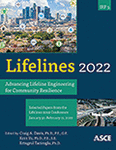Earthquake Damage Prediction of Underground Steel Pipe with Screw Joint Using Machine Learning
Publication: Lifelines 2022
ABSTRACT
In this study, damage to old type steel conduits is predicted using machine learning. We used a supervised machine learning algorithm with a gradient boosting method. To construct the estimation model, we use inspection data from five past large earthquakes: the 1995 Southern Hyogo Prefecture Earthquake, Mid Niigata Prefecture Earthquake in 2004, the Niigataken Chuetsu-oki Earthquake in 2007, the 2011 off the Pacific coast of Tohoku Earthquake, and the 2016 Kumamoto Earthquake. The damage was checked by pipe inspection camera. The model was constructed using 75% of the 23,833 records of the inspection results, and a test was carried out using the remaining 25% of the records. Each record has a label (damaged or no damage), and has 14 variables. Using this method, we constructed a model which has high prediction accuracy, an area under the receiver operating characteristic curve of 0.87 with the test data. The converted displacement in this model contributed the most by confirming the contribution of the respective variables. Old steel conduits with screw joint cannot absorb displacement, and the estimation model may be interpretable.
Get full access to this article
View all available purchase options and get full access to this chapter.
REFERENCES
A. Fisher, C. Rubin, and F. Dominici. (2019). “All Models are Wrong, but Many are Useful: Learning a Variable’s Importance by Studying an Entire Class of Prediction Models Simultaneously.” Journal of Machine Learning Research, Vol.20 (177), 1–81.
A. Ito, M. Okutsu, T. Suzuki, and G. Shoji. (2018). “Development of estimation method of seismic damage for telecommunication conduits.” Earthquake Geotechnical Engineering for Protection and Development of environment and Constructions, 3062–3069.
D. W. Apley, and J. Zhu. (2016). “Visualizing the Effects of Predictor Variables in BlackBox Supervised Learning Models” arXiv 1612.08468.
G. Shoji, F. Miyazaki, M. Wakatake, A. Ito, and T. Suzuki. (2016). “Screening Techniques for Clarification of Seismic Vulnerability of Buried Telecommunication Pipes and Development of Seismic Damage Functions” Journal of Japan Society of Civil Engineers, Ser. A1, Vol. 72, 4, I_523–I_541. (Japanese).
I. Suetomi, E. Ishida, Y. Fukushima, R. Isoyama, and S. Sawada. (2007). “Mixing Method of Geomorphologic Classification and Borehole Data for Estimation of Average Shear-Wave Velocity and Distribution of Peak Ground Motion during the 2004 Niigata-Chuetsu Earthquake” Journal of Japan Association for Earthquake Engineering, Vol.7, Issue 3, 1–12. (Japanese).
Japan Industrial Standards. (2019). Carbon Steel Pipes for Ordinary Piping, JIS-G-3452. (Japanese).
K. Wakamatsu, S. Senna, and K. Ozawa. (2017). “Liquefaction and its Characteristics during the 2016 Kumamoto Earthquake” Journal of Japan Earthquake Engineering, Vol.17, No.4, 81–100 (Japanese).
NIED (National Research Institute for Earth Science and Disaster Resilience). (2011). <http://www.j-shis.bosai.go.jp/>.
NIED (National Research Institute for Earth Science and Disaster Resilience). (2016). Strong-motion Seismograph Networks (K-NET, KiK-net) <https://www.kyoshin.bosai.go.jp/>.
M. Okutsu, N. Ishida, N. Segawa, and Y. Yamazaki. (2012). “Aseismic Capacity of Telecommunication Conduit Repaired with Linings.” Proceedings of 15th WCEE, Lisbon, Portugal, 4138–4145.
Ministry of Land, Infrastructure Transport and Tourism. (2009). National Land Information, <https://nlftp.mlit.go.jp/ksj/index.html>.
O. A. Pineda-Porras, and M. Ordaz. (2007). “A New Seismic Intensity Parameter to Estimate Damage in Buried Pipelines due to Seismic Wave Propagation.” Journal of Earthquake Engineering, 1, 773–786.
O. A. Pineda-Porras, and M. Ordaz. (2012). “Seismic Damage Estimation in Buried Pipelines Due to Future Earthquakes - The Case of the Mexico City Water System.” Earthquake-Resistant Structures, 131–150.
Preferred Networks. (2018). Preferred Networks releases the beta version of Optuna, an automatic hyperparameter optimization framework for machine learning, as open-source software, <https://preferred.jp/en/news/pr20181203-2/>.
S. Senna, and S. Midorikawa. (2009). “Estimation of spectral amplification of ground motion based on geomorphological land classification.” Journal of Japan Association for Earthquake Engineering, Vol. 9, Issue 4, 4_11–25. (Japanese).
T. Chen, and C. Guestrin. (2016). “XGboost: A Scalable Tree Boosting System”, arXiv: 1603.02754.
T. Masuda, and N. Fukuda. (2005). “Mechanical Design of High Pressure Gas Pipeline.” Journal of the Japan Welding Society, Vol. 74, 7, 454–457. (Japanese).
Y. Maruyama, and F. Yamazaki. (2009). “Estimation of Damage Ratio of Water Distribution Pipe Based on Recent Earthquake Data,” Journal of Japan Society of Civil Engineers, Ser. A1, Vol. 65, 1, pp. 565–574. (Japanese).
Information & Authors
Information
Published In
History
Published online: Nov 16, 2022
Authors
Metrics & Citations
Metrics
Citations
Download citation
If you have the appropriate software installed, you can download article citation data to the citation manager of your choice. Simply select your manager software from the list below and click Download.
Cited by
- Mahdi Haghighi, Ali Delnavaz, Pooria Rashvand, Mohammad Delnavaz, Assessment through Machine Learning of Groundwater Vulnerability after Seismic Damage to Fuel Pipeline, Journal of Pipeline Systems Engineering and Practice, 10.1061/JPSEA2.PSENG-1543, 15, 3, (2024).
